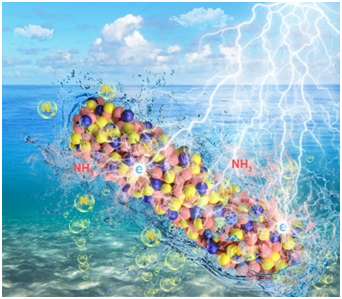Recently, in collaboration with Prof. LIANG Ji from the University of Wollongong (UOW),our group developed Fe-doped W18O49 nanoreactors based on vacancy engineering, which achieved high NH3 yield and outstanding Faraday efficiency simultaneously for Low-barrier Electrochemical Nitrogen Reduction (NRR). The results were published on Angew. Chem. Int. Ed.

Electrocatalytic nitrogen reduction reaction process at room temperature has gain more and more attraction because of its energy-efficient and low-emission advantages comparing to the traditional Haber-Bosch method. Usually, the competing hydrogen evolution reaction (HER) and reaction barrier of ambient electrochemical NRR are most significant challenges, making the simultaneous achievement of a high NH3 yielding rate and a high Faradic efficiency extremely difficult for NRR. Furthermore, reaching this goal at a low overpotential for a more energy-saving electrocatalytic NRR is even more challenging. This is, to some extent, resulted from the limited nitrogen adsorption sites, the sluggish NRR kinetics, and the dominating HER at high overpotentials.
To address this issue, we report a Fe-doped and defect-rich W18O49 nanowire, which is grown on carbon fiber papers, as a freestanding and high performance electrocatalyst for NRR. Combine the calculation of Ab initio, we noticed that the essential low binding energy between tungsten oxide and hydrogen and the maximum exposure of active sites (W) greatly weakened the competing hydrogen evolution reaction and reaction barrier of ambient electrochemical nitrogen fixation. As a result, a high NH3 yielding rate of 24.7 μg h−1 mg and a high Faradic efficiency of 20.0% have been simultaneously realized at a very low overpotential of −0.15 V vs. reversible hydrogen electrode.
and a high Faradic efficiency of 20.0% have been simultaneously realized at a very low overpotential of −0.15 V vs. reversible hydrogen electrode.
Ab initio further revealed Fe intercalation strategy and the modified oxygen vacancy state that simultaneously optimizes the electronic states and surface properties of W18O49, leading to the enhanced nitrogen adsorption strength, and the low-barrier pathway. In the end, this work opens a new avenue for elaborate modulating electrocatalysts of various electrochemical processes.